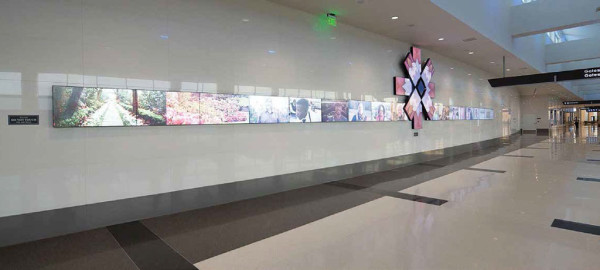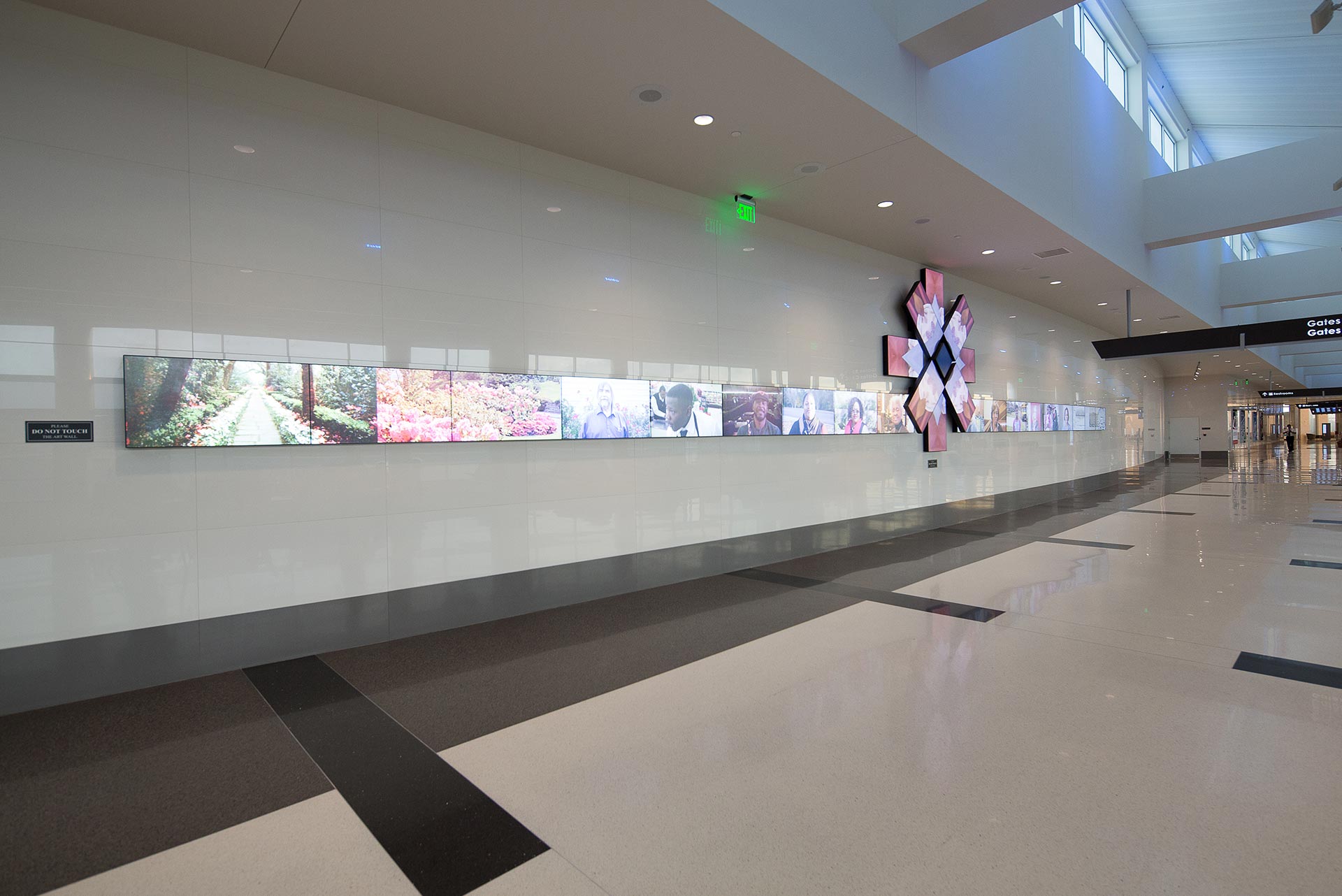Americans travel for work, pleasure, and adventure—and we’re traveling in record numbers. Atlanta’s Hartsfield-Jackson International Airport welcomed an astonishing number of passengers in 2016—more than 104 million—according to Airports Council International. Global passenger traffic is expected to grow 4.5 percent every year through 2040. However, as options increase and consumers become more demanding, transportation hubs need to stay relevant and competitive. Today’s passengers want personalized travel that is tech centric, app enabled, and stress free. It’s a tall order, but audiovisual technologies are playing vital roles in improving transit experiences. Interactive video walls, IoT-connected signage, and immersive AV experiences are helping to refresh transit hubs and bring some good, old-fashioned comfort into the modern journey.
IOT INSIGHTS REDUCE BOTTLENECKS
For Al Lyons, HOK’s senior director of IT and communication engineering—and an expert in 21st century transportation design—Bluetooth low-energy beacons and IoT are proving to be valuable implementations, even before an airport or rail station are open.
“Beacons and IoT can monitor and provide a good record of how people use facilities before construction starts,” Lyons said, “and then throughout the construction process, you can see how people’s experiences are connected and affected.” Real-time metrics on passenger flow, asset movement, and occupancy can become tangible evidence that AV/IT and facilities managers can leverage during planning and performance reviews.
IoT-connected digital signage systems—for wayfinding and revenue-generating advertising—are other elements of a smarter transit design.
INFORMED WAYFINDING, ENHANCED UX
Transportation hubs are ecosystems with many moving parts: restaurants, stores, spas, and hospitality services are all vying for passenger attention. The growing complexity necessitates more dynamic digital wayfinding.
Eduardo Valencia, vice president and chief information officer of Metropolitan Airports Commission (MAC), the organization that provides coordinated aviation services throughout the Minneapolis-Saint Paul Twin Cities metropolitan area, agrees.
“We invest heavily in what matters the most to our passengers, and that includes wayfinding,” Valencia said. Any static signage must be crystal clear, and digital signage must be “dynamic, with the ability to change quickly, related to optimized flow, and optimization of potential escalators, elevator banks, or exits.” Valencia explained that AV continues to be a powerful tool of engagement and enhancing the user experience (UX).
SMARTER HUBS SAVE MONEY AND PROVIDE BETTER SERVICES
A smarter transit infrastructure with connected AV can also save money beyond revenue streams from advertising. Technology managers would need to collaborate with operators to embrace the technology, and then agree on creative means of deployment, but insights gleaned from IoT and IP cameras, for example, can encourage agencies like the TSA to adjust their staffing based on real-time needs.
ARTIFICIAL INTELLIGENCE FOR STREAMLINING LINES
According to Paul Redding of NEC Display Solutions, AV in customer-centric transport environments should remove guesswork and take the anxiety out of traveling.

“AV should make the overall customer journey more satisfying,” he said. To that end, NEC offers a suite of enterprise-grade and touch-enabled digital signage solutions to display flight information and enrich the waiting experience with high-resolution entertainment.
NEC also believes that artificial intelligence (AI) can help streamline operations, and it’s invested in advanced facial recognition software that can help move people through passport control lines more efficiently and securely.
AI-enabled, mobile-connected asset tracking solutions are growing in popularity, as well as the interest in self-service baggage options, another area where NEC is innovating. There are more than 100 integrations of self-baggage solutions and self-boarding units deployed around the world, according to the International Air Transport Association. In 2017, JetBlue worked with United States Customs and Border Protection and SITA, an IT company serving the airline industry, to test a cutting-edge, automated self-boarding process based on biometric information.
Efficient movement is critical in transportation, and every second counts. The pressing question is, “How can we move people in and out of lines faster?” Redding said. “How can we help travelers get where they need to go, as well as spend their free time enjoying retail options?” In this regard, duty free digital signage and other digital merchandising tools add value for commercial tenants and help point passengers to areas of interest.
AV COHESION
Future-forward, AI-enhanced technologies, synced with displays that can be updated on the fly, can provide a cohesive experience as passengers navigate a transit hub. Electronic visual information display systems (EVIDS) are deployed at many airports and train stations with the goal of keeping people safe and updated.
“When we interface EVIDS with what we call an airport operational database, or a station operational database,” Al Lyons explained, “one can coordinate updates of visual information with audible information so that the public address and EVIDS coordinate with each other.”
ACCESSIBILITY
The passengers of tomorrow will be increasingly mobile, so it’s important to build into a 21st-century hub the capabilities to push content to peripheral devices of every make and model. This requires a broader strategy, with input from IT, AV, facilities, and security. Lyons argued that there is value in a more “universal design” with accessibility benefits.
“It is about the ability to integrate different systems so you can support people carrying everything,” Lyons said, “or you can focus on using mobile technology to help people find places and if they cannot hear.”
AV CAPTURES ATTENTION
It’s hard to capture someone’s attention when they are staring down at their phone. Tying large-scale, dazzling LED and LCD walls to content on mobile devices is helping commercial tech managers address the attention challenge.
Lyons shared an anecdote from a recent stadium project with relevance in the transportation vertical. “In that stadium, you have an amazing amount of data that people are putting through on their mobile phones or tablets,” he said. “There are also huge multimedia boards—more than a thousand visual displays. It’s incredible AV technology, but there’s more, in numbers, of tablets and peripherals. These tech-enabled user experiences—the ‘fan experience’ in sports—will migrate over to transit because as people become more familiar with the technology and comfortable using their handheld devices coordinated with installed displays, we will find new ways to bring them together.”
FIBER WILL HELP FUTURE HUBS SOAR
To support the growing appetite for bandwidth-intensive AV content, IP cameras, networked entertainment feeds, and real-time data flows, Al Lyons urged AV/IT managers to invest in fiber.
“Go with fiber everywhere and get rid of the Cat-6 cables,” he said. “Think about the passive optical network or D-PON, and you can get rid of a whole lot of infrastructure. It takes significantly less energy and space to go with passive optical network technology.”
ELEVATED EXPERIENCES
It’s a tricky balance: technology should not distract or impede movement, but it should also make an impression. This is the driving force behind DOOH (digital out-of-home advertising), but it relates to a newer trend in transportation: elevated experiences.

Experience designers are working closely with AV installers to bring more meaning to folks on the go. A compelling example of this is “The Long March,” a 27-tile Planar Mosaic array installed at the recently renovated Birmingham Shuttlesworth International Airport. The Planar Mosaic video wall incorporates depictions of movement, migration, and marching from different eras in Alabama history, such as the Civil War and Selma Marches.
The long horizontal row of Planar Mosaic video tiles track to the center of the wall where they form a dazzling kaleidoscope the shape of a camellia, the Alabama state flower. The digital camellia acts as a “repository of past and present motion that represents the flowering that grows out of movement,” according to a Planar statement. The kaleidoscopic installation, made in collaboration with the CAUSE COLLECTIVE, illustrates how AV can enrich the traveler’s journey, explore identity, and honor history in new, interactive ways.
REMOVE PRESSURE POINTS
For MAC, which oversees the Minneapolis-Saint Paul Airport, the ideal passenger experience is one with exceptional customer service and a seamless feel—not fraught with conflict.
“We strive to create positive and memorable experiences,” Valencia said. A pleasant journey is one that is “free of the pressure points” and negativity often associated with travel. “From the time a passenger enters our facility, perhaps from a mass transit environment, there are a number of steps that we have to assist them,” Valencia said. Those passenger steps include offering pre-book parking options, knowing exactly where to find the ticket lobby, learning accurate wait times, and ordering your favorite caramel macchiato for which you received a digital coupon because you parked on the facility. It also includes access to entertainment you can enjoy on a mobile device that your boarding zone announced on the airport’s paging system.
“We do everything that we can do to create a cohesive, seamless experience with technology throughout the passenger journey—even before you visit us,” Valencia said.
Embrace the Passenger-centric Model
“Capacity constraints coupled with unprecedented growth in aircraft and passenger traffic, as well as competition and the promise of new non-aeronautical revenue streams necessitate a transformation in airports’ value proposition, by leveraging emerging technologies and transitioning from a process-centric to a passenger-centric business model.”
—Renjit Benjamin, Senior Industry Analyst, Frost & Sullivan
Airports Join the Blockchain
“Blockchain, which functions as an online recordkeeping system maintained by a group of peers rather than a central agency or authority, also offers new business opportunities in tracking bags and flight delays.”
More Online
AIRPORTS COUNCIL INTERNATIONAL: STATS ON GLOBAL AIR TRAFFIC
aci.aero
CAUSE COLLECTIVE
causecollective.com
GENSLER RESEARCH INSTITUTE REPORT: AIRPORTS WITHOUT WAITING?
gensler.com/research-insight/gensler-research-institute/near-future-airport
HOK: GLOBAL DESIGN, ARCHITECTURE, AND PLANNING FIRM
hok.com
LEYARD
leyard.com
METROPOLITAN AIRPORTS COMMISSION
metroairports.org

